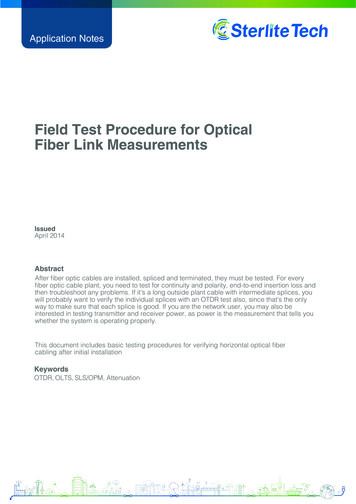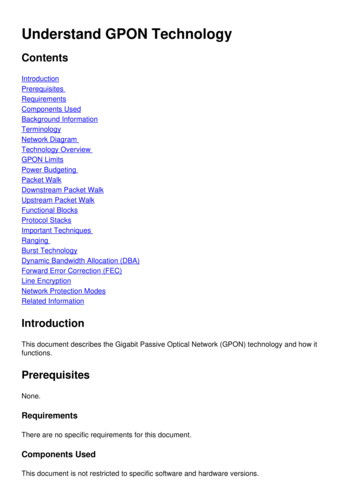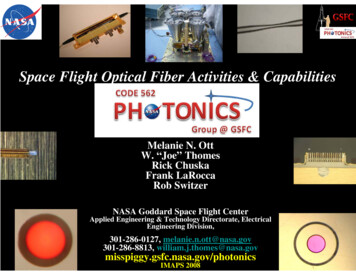
Transcription
Application NotesField Test Procedure for OpticalFiber Link MeasurementsIssuedApril 2014AbstractAfter fiber optic cables are installed, spliced and terminated, they must be tested. For everyfiber optic cable plant, you need to test for continuity and polarity, end-to-end insertion loss andthen troubleshoot any problems. If it's a long outside plant cable with intermediate splices, youwill probably want to verify the individual splices with an OTDR test also, since that's the onlyway to make sure that each splice is good. If you are the network user, you may also beinterested in testing transmitter and receiver power, as power is the measurement that tells youwhether the system is operating properly.This document includes basic testing procedures for verifying horizontal optical fibercabling after initial installationKeywordsOTDR, OLTS, SLS/OPM, Attenuation
1. IntroductionOptical cables are tested by their manufacturer at the factory during and after manufacture,again after delivery to the staging area for the construction project by the contractor or hisagent, and finally after construction by the contactor, his agent, or the end-user. A summary ofthe factory tests are usually provided by the cable manufacturer as part of a cablecharacterization packet accompanying each cable shipped. Pre-construction measurements atthe fiber staging area assure the contractor that there has been no damage done to the cablesduring shipping and handling. Each fiber in all new cable reels should be measured to assurethe fiber possesses the optical properties originally ordered and hasn't been damaged duringshipment and storage:1. Optical continuity in all fibers1.2. Length of each fiber.3. Optical attenuation coefficient of each fiber at user specified wavelengths.Post-construction measurements provide assurance that cable placing, splicing, and linkconstruction activities have been completed that will enable the intended transmission systemto function properly and to provide support for any future maintenance activities on the link. Themost common post-construction measurements include the following:Table 1 – Typical Post-Construction Fiber Link Measurements and Equipment UsedNote:Chromatic dispersion (CD) and polarization mode dispersion (PMD) measurements are notusually made as part of the post-construction measurement program. Both characteristics arenormally issues for high-volume, long fiber lengths as would be encountered in long haul fiberroutes. Chromatic dispersion measurements made at the factory are stable and generally notconsidered sensitive to installation handling, therefore factory supplied chromatic dispersion isnormally used for field installed fibers. PMD is an optical phenomenon that varies from fiber tofiber and with respect to time and must be combined statistically for the respective fibersconcatenated to form the fiber link. PMD can be measured using a PMD test set, but isnormally not an issue unless transmission rates exceed several Gb/sec and fiber link lengthsare very long.Most post-construction optical fiber loss measurements use the cut back method (TIA 455-78)or the back reflection method (TIA 455-8) to determine their measured quantity. The cutbackmethod and the backFiber continuity will be verified by the fiber length measurements and fiberattenuation measurements. ² Stabilized Light Sources1
reflection method are mainly used for testing at the manufacturing facility and the backreflection method is normally used in the field for most tests. An optical time domainreflectometer (OTDR) is the back reflection, portable optical test set used in the field for pre andpost-construction fiber measurements. The backscatter concept is illustrated in Figure 1.Figure 1 – Schematic of the Backscatter PhenomenaWhich OTDRs Use to Make MeasurementsNote: Following the OTDR manufacturer's instructions, set the fiber group index to 1.4670 formeasurements at 1310 nm and 1.4675 for measurements at 1550 nm. The group index is usedby the OTDR to convert time-of-flight of OTDR pulse to distance.2. Safety2.1 Laser precaution:IMPORTANT: Laser or LED beams used in testing optical fiber plant are invisible and canseriously damage the eyes. Viewing these signals directly does not cause any pain andthe iris of eye does not close automatically as it would when viewing bright lights.Communications lasers can cause serious damage to the retina of eye if view directly.Therefore, Never look directly into a fiber having a laser or LED coupled to it. If the eye is accidentally exposed to a laser or LED beam, immediately take theindividual to a medical facility for treatment.2.2 Optical Fiber Handling PrecautionBroken fiber ends (splinters) created during termination and splicing can easily penetrate theskin and can be dangerous. Fiber splinters will result as the fiber is cleaved. Fiber splinters arehard to find and remove once imbedded in the skin. Tweezers and an eye loupe are needed toremove the splinters. Any delay in
removing fiber splinters from the body could lead to infection. Hence: Be careful while handling the fibers. Do not drop fiber pieces on the floor where they will stick in carpets orshoes and be carried elsewhere. Dispose of all splinters and scraps safely and properly. Do not eat or drink near the installation area.3 Post-Construction Measurements SetupFigure 2 and Figure 3 provide schematic drawings of the two primary setups that arecommonly used to test new fiber links: first, using an OTDR with a lead- in fiber and second,using two optical loss test setsor a stabilized light source and optical power meter.Figure 2 – Schematic Setup of OTDR Used to Measure Link Loss of FiberConnected to Lead-in FiberFigure 3 – Schematic Setup of OLTS or SLS/OPM Used to Measure Fiber Link Loss
3.1 Post-Construction Measurement ProcedurePost-construction testing can be seen as an expensive and time consuming operation. It is,however, a necessary operation to verify the quality of the construction operation that just hasbeen completed and to provide a data base that will provide useful information if and whenfuture maintenance is required on the fiber link. The post-construction testing procedure will beoptimized with respect to time and cost using the test procedures described in this testing note.Connecting the OTDR with Lead-In Fiber to the FDF and New Fiber LinkA lead-in or launch fiber should be used to eliminate the effect of the dead zone created fromthe OTDR's fiber interface connector and to enable the loss of the near-end, lead-in fiber/FDF/fiber-under-test connection to be determined. A lead-in fiber is several hundred meters inlength. It connects the OTDR to the fiber being measured. When fiber measurements aremade, it enables an accurate measurement of the connection between the lead-in fiber and thenew fiber, a more accurate measurement of the new fiber length, and the total end-to-end lossof the new fiber link. The lead-in fiber is a commercially available OTDR accessory with aconnector on one end to match the OTDR network interface and a connector on the other endto match the connector encountered on the fiber-under-test or FDF. Lead-in fibers are useful tolocate faults at short distances into the link.Using isopropanol and a lint free wiper, clean the optical connectors at both ends of the lead-infiber. Connect the lead-in-fiber to the OTDR output port to observe the fiber measurement traceand FDF port to which the fiber-under-test is connected. A spike in the left end of the fiber tracewith a rounded or flattened peak (see Figure 4 ) ) will mark the connection to the lead-in fiber atthe OTDR and the start of the trace. To the right of this peak the fiber trace should be smoothwith a continuous linear slope of the lead-in fiber. If necessary, re-clean the mating ends of thelead-in fiber/FDF connector to obtain the OTDR trace as shown in Figure 4 .Figure 4 – Typical OTDR Trace Showing Lead-in FiberConnected to the Post-Construction FiberLinkThe connection at the FDF is shown as non-reflective in Figure 4. It may be somewhatreflective, depending upon the connector used at this location, see Figure 5.
NOTE: Clean all connectors properly and keep FDF ports and lead-in fiber connectorendscapped when not in use. Dirty connectors can cause permanent damage to the OTDR orthe connecting fiber end and will usually be the cause of OTDR measurement problems.Each fusion splice in the fiber link will appear as small steps in the linear down slope of the fibertrace (see Figure 4 ). The vertical height of the splice offset is equal to the optical attenuation ofthe splice. The reflectance of a reflective connection is proportional to the height of the spike ofits OTDR fiber trace. Its loss is the same as for a fusion splice: the vertical offset of the fibertrace. Figure 5 illustrates these issues when measuring splice or event loss and reflections.Figure 5 – Key Portions of an OTDR Trace for Non-Reflective and Reflective Fiber Events3.2 Length MeasurementConnect the lead-in fiber to the fiber-under-test at its FDF port.1. Set the OTDR to “auto” testing³ and verify that the OTDR's group index is set to theappropriate value to match that of the fiber-under-test (see Section ). The fiberlink trace shown in will appear on the OTDR.Once a clean, proper fiber connection is made, electronically record and observe the OTDR fiber trace.³ “Auto” testing will cause the OTDR to automatically select the appropriate measurement range and pulse width to optimallymeasure the fiber link under test. Otherwise, consult the OTDR manual to manually select the correct measurement parameters forthe fiber measurement.
Figure 6 - Typical OTDR trace to determine the fiber length of fiber link under test.Figure 6 and Figure 7 show the key cursor positions on the fiber trace to measure the fiberlength. Set “cursor 1” to the connection at the FDF port between the lead-in fiber and fiberunder-test. It should be positioned at the entry point to the connection where the trace beginsto drop from the lead-in, linear backscatter level through the attenuation of the temporaryconnection at the FDF or if the connection is reflective, it shall be positioned at the entry point tothe FDF connection where the trace begins to rise from the reflective connection.Figure 7 – Key Cursor Locations on OTDR Trace to Measure Fiber LengthThe trace should have a slightly rounded or square peak at the far end of the fiber (see ).Since the fiber end is reflective, “cursor 2” shall be positioned at the last point on the linearlead-in to the reflective spike at the end of the fiber trace. The difference between the twocursor positions is the length of fiber in the cable under test.
NOTE: The cable sheath length will be several percent shorter than the fiber lengthbecause of the fiber stranding used within the cable core.If available on the OTDR, activate the algorithm that automatically summarizes the entire fiberlink trace (fiber lengths, splice loss, event reflectance, end-to-end link loss, and optical returnloss) in tabular form. Save this table and the fiber trace electronically, for future reference.3.3Fiber Attenuation3.3.1OTDR MeasurementWhile the OTDR is still attached to the fiber just measured for length, it should be measured withthe OTDR to determine its attenuation at the working wavelengths for which it was specified.Set the OTDR to the first wavelength to be measured and obtain the fiber trace shown in Figure8. The vertical offset between the intersection points on the fiber trace between cursor 1 andcursor 2, respectively, is equal to the fiber link loss. This vertical offset is equal to the fiber linkloss including the loss of the FDF connection at the beginning of the fiber. While the FDFconnector is a loss that the transmission signal will experience, many definitions of link lossinclude only the fiber between FDFs, not the loss of either FDF connector. This loss is shown bythe height of the yellow box in Figure 8 .Figure 8 – Typical OTDR trace to determine the attenuation of fiber link under test.To determine the fiber link loss without including the FDF connectors, the link loss determinedabove in Figure 8 must be decreased by the calculated loss of the near-end FDF connection(lead-in fiber/FDF/fiber-under-test connection) calculated using the splice loss routine of theOTDR (see OTDR manual).The near end FDF connector loss is calculated as is shown in Figure 9. Generally, amore accurate determination of splice or connector loss is achieved using the OTDR's leastsquare methodas compared to its two point method.
Figure 9 – Measure the splice loss at FDF between lead-in fiber and fiber link being measured.The fiber-link, end-to-end loss is determined by subtracting the near-end FDF connector lossfrom the fiber link loss that includes the FDF connector loss (shown in Figure 8), using theprinciples of Figure 9.The fiber attenuation coefficient is often characterized by reporting the attenuation coefficient ofthe fiber at a specific wavelength. The attenuation coefficient is defined as the optical power lossin the fiber per unit length, dB/km, and is equal to the slope of the linear, backscatter portion ofthe OTDR fiber trace when the optical power is at the specified wavelength.If the fiber link loss is specified at more than one wavelength, the OTDR measurement shall bemade one at a time at each wavelength specified in the work plan. Typically, the attenuationthresholds at both 1310 and 1550 nm are specified for long-haul, single-mode fibers; attenuationthresholds at 1310, 1550, and 1490 nm, respectively, are frequently specified for FTTH fibers.3.3.2OLTS or SLS/OPM MeasurementWhile OTDRs may provide the most economical solution to post-construction measurementissues, many experts may argue that the end-to-end loss using an OTDR is an estimate of theactual end-to-end loss of the fiber link. Many companies may prefer to use a pair of optical losstest sets (OLTSs) or a stabilized light source (SLS) and an optical power meter (OPM) to makethis measurement. Figure 10 shows a typical setup to measure the link loss of fiber using an OLTSor SLS/OPM.OLTS testing requires access to both ends of the fiber link. A single unit has both a transmitterand receiver. It works with its partner unit positioned at the opposite end of the link to makeloss measurements between units. The units communicate with each other and makemeasurements at several preselected wavelengths in both directions along the fiber link. Theyalso provide a bidirectional average of the link-loss at each respective measurement wavelength.As part of the initial setup procedure for each measurement, the mating OLTS units need to bezeroed to each other's output power levels. Some OLTSs provide automatic zeroing; othersrequire the users to perform this operation (see the OLTS operating manual).
Figure 10 – Fiber Link End-to-End Measurements Using an OLTS or SLS/OPMThis same measurement can be made between a SLS and an OPM at the preselectedwavelengths that represent the working transmission wavelengths. These units must be zeroedat the start of the measurement process.NOTE: To improve measurement accuracy, keep the fiber jumper used for the measurementsinstalled in the transmitter (OLTS or SLS) for the duration of the measurement session. Allconnections need to be thoroughly cleaned using a lint-free wiper and isopropyl alcohol.3.4Remaining OTDR Fiber MeasurementsThe remaining measurements described in this section are made at the same time as the OTDRfiber length measurements and attenuation measurement discussed in the preceding twosections.Activate the OTDR algorithm that automatically summarizes in tabular form the fiber linktrace characteristics found by the OTDR after it produced the fiber link trace shown (fiberlengths, splice loss, reflectance, end-to-end link loss, and optical return loss). Save this tableand the fiber trace electronically, for future reference.Fiber reflectance – Will be located with the OTDR measurements of each fiber pathway, seesplice loss. Normally, fiber reflectance limits require that all events have a reflectance. Fiberreflectance occurs at fiber connections and from the end face of a broken fiber. Fusion spliceswill not be reflective.Optical return loss of link – This may not be a measurement that will be required as part of theplacing “proof-of-compliance measurements.” If it is required, it can be determined with anOTDR measurement for each fiber pathway.Fiber continuity – Fiber continuity will be determined when the OTDR measurements are made.These measurements will confirm continuity. If a light source and power meter are used, thereceipt of light at the power meter (located at the far FDF) will assure the continuity of the fiberpathway.
A.6 Measurement Tips If a stabilized light source (SLS) is used with an optical power meter (OPM) to make link lossmeasurements, the OPM must be referenced to the SLS output power beforethe loss measurement is made. The same referencing operation is required formost optical power loss test sets (OLTSs).To minimize measurement error, the optical jumper attached to the output port of the SLS or OLTS for the reference power measurement should remain attachedfor all link loss measurements for the complete session (until the next equipmentzeroing). Always make measurements with clean connectors. Use an alcohol dampenedwiper to clean the end of the mating connector ferrules used to connect the testsets to and from the fiber link. Canned air can also be used to blow off any ferruleor connector housing for dust both before and after cleaning with isopropylalcoholand a lint-free wiper. Avoid kinking or inducing sharp bends (smaller than a golf ball) into fiber testjumpers.If no wavelengths are specified for the post-construction measurements,measurements should be made at 1310 nm and 1550 nm.4 ConclusionsIf the post-construction measurements confirm the fiber link's ability to provide a physicaltransport medium that will match or exceed the proposed transmission system's performancerequirements, the construction has been confirmed and the measurements are complete.Otherwise the fiber link must be trouble-shot to locate the problem and repairs must be made.All OTDR fiber traces and OLTS test results determined during the post-constructionmeasurement program should be saved for future reference if problems develop during thefiber's service life. If the post-construction measurements indicate some inherent fiber damageor noncompliance with respect to performance, the cable manufacturer should be notifiedimmediately, so the problem can be investigated and rectified.5 Additional InformationIf there are additional questions on this topic or other fiber optic issues, please contact SterliteTechnologies at:Contact echnologies.comCopyright 2017 Sterlite Technologies Limited. All rights reserved. The word and design marks set forthherein are trademarks and/or registered trademarks of Sterlite Technologies and/or related affiliates andsubsidiaries. All other trademarks listed herein are the property of their respective owners.www.sterlitetech.com
Since the fiber end is reflective, "cursor 2" shall be positioned at the last point on the linear lead-in to the reflective spike at the end of the fiber trace. The difference between the two cursor positions is the length of fiber in the cable under test. Figure 6 - Typical OTDR trace to determine the fiber length of fiber link under test.











